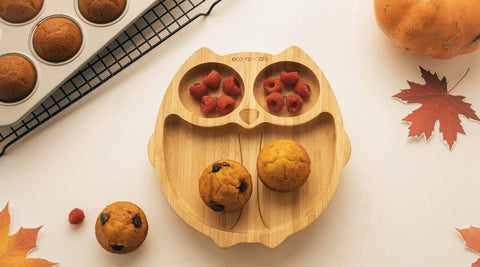As your little one grows and reaches the age of roughly six months, it's time to embark on an exciting milestone – introducing solid foods into their diet. This journey is known as weaning, and it marks a significant step in your child's development as they transition from exclusive breastfeeding or formula feeding to exploring the world of flavors and textures. In this guide, we'll take you through the basics of starting your little one's weaning journey.
Signs of Readiness
Size, sleep patterns and unsettledness are not signs that your baby is ready to start weaning. There are clear developmental milestones that indicate your baby is ready for weaning and these are usually hit at around the 6 month mark- Look out for the following signs:
- Sitting Upright: Your little one should be able to stay in a seated upright position with little to no aid. It's not essential that they can get to upright position alone, but they need to be able to maintain it.
- Head Control: They should be able to independently support and hold their head steady.
- Tongue Reflex: Babies have a tongue-thrust reflex whereby babies will automatically push food out of their mouths rather than attempt to chew, taste or swallow. This automation should have started to diminish.
- Hand to mouth: Your baby should be able to pick something up and bring it to his/her mouth.
- Interest: Finally, your baby might be showing interest in your food by reaching out and trying to grab it or just by watching you intensely as you eat.

Introducing Solid Foods
When starting weaning, it's essential to be patient and go at your baby's pace. It is completely normal for your child to only attempt a teaspoon or tablespoon of food a day in the first couple of weeks.
Here are some steps to help you ease into the process:
1. Mix it up: All too often, we see the question being asked whether parents will traditional wean (purees) or baby-led-wean (finger food). It's essential for children to enjoy and try all textures of food so we suggest introducing single-ingredient foods in a variety of textures. Try smooth, try lumpy and try whole finger sized and see which one your baby prefers.
2. One New Food at a Time: Introduce one new food every few days to check for any allergic reactions or intolerances. This also helps you identify the foods your baby enjoys.
3. Four to one rule: Babies normally enjoy natural sugary fruits over more bitter vegetables. We suggest introducing lots of veggies first and then adding in fruit to these vegetables with a 4 vegetable and one fruit ratio.
4. Follow Their Cues: Watch for cues that your baby is full or uninterested in food. Don't force them to eat if they're not willing.
5. Be Mess-Tolerant: Weaning is a messy process, and it's completely normal. Embrace the chaos and let your little one explore and enjoy their food.
Nutritious Foods for Weaning
As you introduce solid foods, it's essential to offer a balanced and nutritious diet for your growing baby. Our bamboo section plate are made to support parents to do just this! We supply the sections so you can supply the different food groups!
Watch our video about the first 20 foods to try.
Foods to Avoid
While exploring new foods, there are some items you should avoid giving to your baby:
1. Honey: Honey can contain bacteria that may be harmful to infants under one year old.
2. Salt and Sugar: Avoid adding salt or sugar to your baby's food, as their kidneys are not yet developed to handle excess amounts.
3. Choking Hazards: Steer clear of whole nuts, grapes, popcorn, and other small, hard foods that could pose a choking risk.
4. Cow's Milk: Avoid cow's milk as a main drink until your baby is one year old. You can use it in cooking or mixed with food after nine to ten months.
If you have concerns about your child and food allergies, we recommend speaking to your doctor and watching out for these common allergens:
Hydration and Milk Feeds
Even as you introduce solid foods, remember that breast milk or formula is still essential for your baby's nutrition. Keep offering regular milk feeds between mealtimes to ensure they stay hydrated and get the necessary nutrients.
Enjoy the Journey!
Weaning is an exciting and adventurous phase for both you and your little one. It's a time to explore new tastes, textures, and discover the joy of food together. Be patient, be flexible, and most importantly, have fun as you embark on this journey of introducing solid foods to your baby. Every child is unique, so trust your instincts and let your baby guide you through their weaning experience. Happy weaning!





Comments (0)
There are no comments for this article. Be the first one to leave a message!